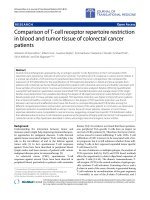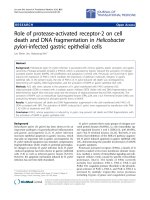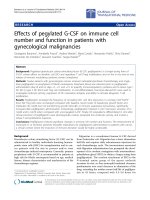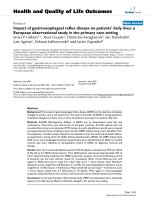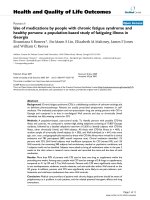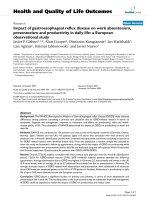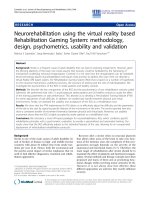báo cáo hóa học:" Modification of the asthma quality of life questionnaire (standardised) for patients 12 years and older" pdf
Bạn đang xem bản rút gọn của tài liệu. Xem và tải ngay bản đầy đủ của tài liệu tại đây (221.32 KB, 6 trang )
BioMed Central
Page 1 of 6
(page number not for citation purposes)
Health and Quality of Life Outcomes
Open Access
Research
Modification of the asthma quality of life questionnaire
(standardised) for patients 12 years and older
Elizabeth F Juniper*
1
, Klas Svensson
2
, Ann-Christin Mörk
2
and
Elisabeth Ståhl
2
Address:
1
Department of Clinical Epidemiology and Biostatistics, McMaster University, Hamilton, Canada and
2
AstraZeneca R&D, Lund, Sweden
Email: Elizabeth F Juniper* - ; Klas Svensson - ; Ann-Christin Mörk - Ann-
; Elisabeth Ståhl -
* Corresponding author
Abstract
Background: The age limit for some adult asthma clinical trials has recently been lowered to 12
years. In this study we have made minor modifications to the standardised version of the adult
Asthma Quality of Life Questionnaire (AQLQ(S)) to make it valid for patients 12 years and older
(AQLQ12+).
Methods: We have used two clinical trial databases, in which the AQLQ12+ was used, to compare
the measurement properties of the questionnaire in patients 12–17 years and patients 18 years and
older. A total of 2433 patients (12–75 years), with current asthma and with data that could be
evaluated both at randomisation and end of treatment, were included.
Results: The analysis showed that internal consistency, responsiveness and correlations with
other clinical indices were very similar in patients 12–17 years and patients 18 years and older.
Conclusion: The measurement properties of the AQLQ12+ are similar in adolescents and adults
and therefore the instrument is valid for use in adult studies which include children 12 years and
older.
Background
The Asthma Quality of Life Questionnaire (AQLQ) was
developed to measure the functional impairments experi-
enced by adults 17 years and older [1]. It has 32 items in
four domains (symptoms, activity limitations, emotional
function and environmental stimuli). In the original
AQLQ, five of the activity questions are patient-specific
but this proved time-consuming and troublesome in large
clinical trials. To address this problem, we developed the
standardised version (AQLQ(S)). In the AQLQ(S) all the
activity questions are generic and its measurement prop-
erties that are almost the same as those of the original
AQLQ [3]. The Paediatric Asthma Quality of Life Ques-
tionnaire was developed to measure the problems that
children 7–17 years experience [2]. It has 23 items in three
domains (symptoms, activity limitations and emotional
function). Recently, adolescents 12 years and older have
been included in adult asthma clinical trials. To avoid
using two separate health-related quality of life question-
naires in these studies, we have modified the AQLQ(S) [3]
to make it suitable for both adolescents and adults. The
AQLQ(S) was selected in preference to the original AQLQ
because it is the version of the questionnaire most com-
monly used in clinical trials.
Published: 16 September 2005
Health and Quality of Life Outcomes 2005, 3:58 doi:10.1186/1477-7525-3-58
Received: 08 July 2005
Accepted: 16 September 2005
This article is available from: />© 2005 Juniper et al; licensee BioMed Central Ltd.
This is an Open Access article distributed under the terms of the Creative Commons Attribution License ( />),
which permits unrestricted use, distribution, and reproduction in any medium, provided the original work is properly cited.
Health and Quality of Life Outcomes 2005, 3:58 />Page 2 of 6
(page number not for citation purposes)
The aim of this adaptation was to ensure that the prob-
lems that are most troublesome to adolescents were
included whilst making as few modifications to the origi-
nal as possible. We have used two clinical trial databases
to compare the measurement properties of the AQLQ(S)
for 12 years and older (AQLQ12+) in patients 12–17 years
and patients ≥ 18 years.
Methods
Modification of the AQLQ(S)
Both the AQLQ [1] and the Paediatric Asthma Quality of
Life Questionnaire (PAQLQ) [2] were developed by ask-
ing adults and children respectively about the problems
and limitations that are most important to them in their
daily lives as a result of their asthma. Items that were most
frequently experienced and most troublesome for the two
groups and which are included in the two questionnaires
[1,2] are shown in Tables 1 and 2. After reviewing the two
questionnaires, only one word needed to be added to the
AQLQ(S) to make it suitable for adolescents 12 years and
older. As can be seen in Tables 1 and 2, symptoms and
activity limitations are very similar in adults and children
and the only change necessary was to alter the activity
question about 'work-related limitations' to ask about
'work-/school-related limitations'. Although children
identified sleep as a troublesome activity, this is already
included in the symptom domain of the AQLQ. There is
no environmental stimuli domain in the PAQLQ because
children tend to express their problems with the environ-
ment in terms of activity limitation. For instance, an adult
will say 'I am bothered by cigarette smoke', a young child
will say 'I can't go to my friend's house because her mum
smokes'. We considered that as adolescents (12–17 years)
are moving towards adulthood, they would be old
enough to express directly, rather than indirectly, their
problems with environmental stimuli. Although children
experience similar fears and frustrations to adults, they
also 'feel different and left out'. Since none of the emo-
tional function questions in the AQLQ could be modified
to take this into account and since adding a separate ques-
tion would have altered the weighting of the domain and
overall score, 'feel different and left out' has not been
included in the AQLQ12+.
Studies and patients
The analysis was conducted using databases from two
clinical trials. Full details of one trial have been published
elsewhere [4]. The second trial has been published as
abstracts [5,6]. The first trial was a 12-month, ran-
domised, double-blind, parallel group study comparing
two active interventions. Of the 1890 patients ran-
domised, 1770 completed the AQLQ12+ at baseline and
either at the end of 12 months or on withdrawal. The sec-
ond study was a 12-week randomised trial comparing
three active interventions. Of the 680 patients ran-
domised, 655 completed the AQLQ12+ at randomisation
and either at 12 weeks or withdrawal. In both studies,
patients were required to have inadequately controlled
asthma with no evidence of any other respiratory disease
and to be between the ages of 12 and 80 years.
Outcomes
Asthma Quality of Life Questionnaire for 12 years and older
(AQLQ12+)
Patients are asked to recall their experiences during the
previous 2 weeks and to score each of the 32 questions on
a 7-point scale from 7 = no impairment to 1 = severe
impairment. The overall score is calculated as the mean
response to all questions. The four domain scores (symp-
toms, activity limitations, emotional function and envi-
ronmental stimuli) are the means of the responses to the
questions in each of the domains.
Symptom and Medication Diary
Each morning and evening patients scored how much
they were bothered by their asthma symptoms on a 4-
Table 1: Functional impairments most important to adults (17–70 years) (1)
Symptoms Emotions Activities Environment
Short of breath Afraid of not having medications available Exercise/sports Cigarettes
Chest tightness Hurrying Dust
Wheeze Afraid of getting out of breath Social activities Air pollution
Cough Concerned about the need to use medications Pets Cold air
Tired Frustrated Work/housework Pollen
Table 2: Functional impairments most important to children (7–
17 years) (2)
Symptoms Activities Emotions
Short of breath Sports and games Feel different and left out
Chest tightness Activities with friends Frustrated
Cough Playing with pets Angry
Wheeze School activities Sad
Tired Sleeping Frightened/anxious
Health and Quality of Life Outcomes 2005, 3:58 />Page 3 of 6
(page number not for citation purposes)
point scale (0 = no symptoms and 3 = unable to do nor-
mal daily activities (or sleep) because of asthma) and
recorded the amount of rescue medication taken. Each
morning they recorded whether they had been woken
during the night by asthma symptoms. They also meas-
ured pre-bronchodilator PEF each morning and evening,
recording the best of three blows. For this analysis, we
have estimated the mean diary scores for the 2 weeks that
were co-incident with the AQLQ12+ two week recall
period.
Spirometry
Pre-bronchodilator FEV
1
% predicted normal was
recorded at all clinic visits.
Statistical analysis
Since the validity of the AQLQ(S) has already been estab-
lished in adults and because only one word was added to
the AQLQ(S) for the modification, AQLQ12+ scores for
adults (18–80 years) have been considered the gold stand-
ard for this analysis (criterion validity). Data collected at
baseline were used to determine differences between age
groups (unpaired t-test) and internal consistency (Cron-
bach's alpha). Change in scores between baseline and end
of treatment, adjusted for treatment effect and baseline
values by a linear ANOVA model, were used to determine
responsiveness. Cross-sectional and longitudinal con-
struct validity were evaluated by examining Pearson corre-
lation coefficients between the AQLQ12+ and both diary
symptoms and airway calibre.
Results
2423 patients were included in the analysis. There were
2207 over 18 years and 216 between 12 and 17 years
(Table 3). In the older patients there were slightly more
women than men and in the younger patients slightly
more men than women. FEV
1
% predicted was slightly
higher in the younger patients.
At baseline in both studies, there was no evidence of any
difference in AQLQ12+ scores both for overall AQLQ12+
scores and for the symptom and emotional function
Table 3: Demographics and baseline values
Study 1 Study 2
≥ 18 years 12–17 years ≥ 18 years 12–17 years
Number of patients 1652 116 555 100
Mean age (range) 44.8 (18–80) 14.3 (12–17) 44.6 (18–79) 13.9 (12–17)
Gender M/F (%) 41.1/58.9 57.8/42.2 33.5/66.5 53.0/47.0
FEV
1
% pred. (range) 75.4 (32–136) 83.9 (47–125) 73.3 (41–107) 77.8 (54–114)
Table 4: Standardised version of the Asthma Quality of Life Questionnaire for 12 years and older (AQLQ12+)
AQLQ12+ Mean Score at baseline Mean change score during treatment
(adjusted means)
Internal Consistency at
baseline
Cronbach's alpha
≥ 18 yr 12–17 yr p value ≥ 18 yr 12–17 yr p value ≥ 18 yr 12–17 yr
Study 1
Overall 4.95 5.14 0.063 0.58 0.47 0.17 0.96 0.95
Symptoms 4.87 4.96 0.40 0.65 0.57 0.41 0.93 0.92
Activity limitation 5.09 5.41 0.002 0.52 0.39 0.12 0.91 0.86
Emotional function 5.06 5.11 0.68 0.57 0.46 0.26 0.87 0.77
Environmental stimuli 4.64 4.94 0.028 0.54 0.4 0.16 0.82 0.77
Study 2
Overall 4.69 4.72 0.82 0.66 0.59 0.52 0.97 0.97
Symptoms 4.68 4.64 0.73 0.73 0.67 0.60 0.94 0.95
Activity limitation 4.81 4.96 0.25 0.57 0.51 0.57 0.92 0.91
Emotional function 4.74 4.68 0.70 0.76 0.62 0.27 0.86 0.91
Environmental stimuli 4.24 4.43 0.24 0.57 0.56 0.96 0.84 0.88
Health and Quality of Life Outcomes 2005, 3:58 />Page 4 of 6
(page number not for citation purposes)
domain scores (Table 4). However, in study 1, 12–17 year
old patients were less troubled by activity limitations and
environmental stimuli than older patients but the differ-
ences were small (< 0.35) and cannot be considered of
clinical importance [5]. These differences were not seen in
study 2. After adjusting for treatment and baseline values,
changes in AQLQ12+ scores during the treatment period
were similar in the two age groups for both studies (Table
4). As further evidence of the validity of the AQLQ12+ in
adolescents, internal consistency was similar in the two
age groups (Table 4) and correlations between each
domain of the AQLQ12+ and other measures of asthma
clinical status were also very consistent in the two age
groups (Tables 5 and 6).
Discussion
The results of this analysis have shown that measurement
properties of the AQLQ12+ in both adolescents and
adults are very similar and that the AQLQ12+ can
therefore be used in adult clinical trials that include
adolescents.
Since only one word change was needed to make the
AQLQ(S) to be suitable for adolescents and because both
the original AQLQ and the AQLQ(S) have undergone
extensive validation in adults [7-11], we have considered
the AQLQ12+ in adults (≥18 years) to be the gold stand-
ard with which to compare the measurement properties of
the AQLQ12+ in adolescents. In both studies at baseline,
there was no evidence of any differences in the overall or
domain scores except for the activity limitation and envi-
ronmental stimuli domains in study 1, where small but
clinically unimportant differences were observed (the
minimal important difference for the AQLQ is 0.5 on the
7-point scale [12]). Changes in scores during treatment
and internal consistency were very similar in both age
groups in both studies. These data strongly support the
validity of the AQLQ(S)12+ in adolescents. There was a
very slight tendency for correlations with other clinical
indices to be slightly lower in adolescents but this is most
likely attributable to a slight difference in the relationship
between quality of life and clinical asthma in the two age
groups. Even if this is not the reason, the tendency is so
small that it not sufficient to suggest lack of validity of the
AQLQ12+ in adolescents.
The results of this analysis should not be interpreted to
mean that the AQLQ12+ is the most appropriate asthma-
specific quality of life questionnaire for adolescents. To
evaluate the impact of asthma on individual adolescents
in the clinic or to estimate the effect of interventions on
adolescents alone, it would be wise to continue to use an
Table 5: Cross-sectional construct validation (Baseline) (Pearson correlation coefficients)
Study 1
AQLQ12+ Age FEV
1
% pred PEF Symptoms Night waking Rescue bd
Overall ≥ 18 yr 0.15 0.29 -0.50 -0.50 -0.35
12–17 yr -0.11 0.13 -0.37 -0.38 -0.21
Symptoms ≥ 18 yr 0.14 0.22 -0.53 -0.54 -0.39
12–17 yr -0.11 0.15 -0.34 -0.40 -0.23
Activities ≥ 18 yr 0.14 0.32 -0.47 -0.45 -0.29
12–17 yr -0.13 0.15 -0.37 -0.35 -0.16
Emotions ≥ 18 yr 0.15 0.25 -0.36 -0.35 -0.28
12–17 yr -0.10 0.05 -0.28 -0.27 -0.23
Environment ≥ 18 yr 0.07 0.24 -0.34 -0.36 -0.22
12–17 yr -0.01 0.06 -0.25 -0.25 -0.12
Study 2
AQLQ12+ Age FEV
1
% pred PEF Symptoms Night waking Rescue bd
Overall ≥ 18 yr 0.06 0.23 -0.49 -0.47 -0.35
12–17 yr 0.03 0.37 -0.46 -0.39 -0.28
Symptoms ≥ 18 yr 0.06 0.17 -0.56 -0.54 -0.42
12–17 yr 0.04 0.32 -0.49 -0.42 -0.32
Activities ≥ 18 yr 0.06 0.28 -0.40 0.41 -0.28
12–17 yr 0.05 0.35 -0.42 -0.41 -0.21
Emotions ≥ 18 yr 0.06 0.18 -0.36 -0.36 -0.25
12–17 yr -0.02 0.36 -0.32 -0.31 -0.25
Environment ≥ 18 yr 0.03 0.21 -0.34 -0.34 -0.23
12–17 yr -0.01 0.40 -0.43 -0.36 -0.25
Health and Quality of Life Outcomes 2005, 3:58 />Page 5 of 6
(page number not for citation purposes)
instrument that has been specifically developed for this
age group. The PAQLQ [2], for instance, includes all the
problems that children between 7 – 17 years have identi-
fied as important and uses the words that they are most
likely to use.
Conclusion
The results of this analysis suggest that the AQLQ12+ is
valid for measuring asthma-specific quality of life in
adolescents 12–17 years. The similarity of the measure-
ment properties of the AQLQ12+ in patients 12–17 years
and over 18 years provides evidence that data from the
two groups can be combined for analysis of adult clinical
trials and surveys that included patients 12 years and
older.
List of abbreviations
AQLQ Asthma Quality of Life Questionnaire
AQLQ(S) Standardised version of the Asthma Quality of
Life Questionnaire
AQLQ12+ Standardised version of the Asthma Quality of
Life Questionnaire for 12 years and older
FEV
1
Forced Expiratory Volume in 1 second
PAQLQ Paediatric Asthma Quality of Life Questionnaire
Authors' contributions
EFJ: Design of the analysis, interpretation of data, primary
author of manuscript.
KS: Statistical analysis, development of study question,
drafting of manuscript.
ACM: Development of study question, drafting of manu-
script, study co-ordinator.
ES: Development of study question, drafting of
manuscript.
All four authors have played a major part throughout the
entire study process from the development of the study
question to the revision of the final manuscript. Each of
the four authors has made a significant contribution at
each phase of the study.
Table 6: Longitudinal construct validity (Baseline – End of study) (Pearson correlation coefficients)
Study 1
AQLQ12+ Age FEV
1
% pred PEF Asthma symptoms Night-time awakening Rescue medication use
Overall ≥ 18 yr 0.3 0.33 -0.43 -0.42 -0.39
12–17 yr 0.06 0.29 -0.33 -0.2 -0.24
Symptoms ≥ 18 yr 0.32 0.34 -0.46 -0.46 -0.43
12–17 yr 0.03 0.3 -0.33 -0.26 -0.25
Activity limitation ≥ 18 yr 0.27 0.28 -0.39 -0.37 -0.33
12–17 yr 0.08 0.26 -0.33 -0.18 -0.21
Emotional function ≥ 18 yr 0.25 0.29 -0.3 -0.31 -0.33
12–17 yr -0.06 0.12 -0.22 -0.11 -0.2
Environmental stimuli ≥ 18 yr 0.16 0.19 -0.25 -0.2 -0.2
12–17 yr 0.19 0.3 -0.21 0 -0.16
Study 2
AQLQ12+ Age FEV
1
% pred PEF Asthma symptoms Night-time awakening Rescue medication use
Overall ≥ 18 yr 0.21 0.41 -0.51 -0.41 -0.37
12–17 yr 0.23 0.24 -0.45 -0.3 -0.2
Symptoms ≥ 18 yr 0.23 0.4 -0.56 -0.47 -0.43
12–17 yr 0.26 0.29 -0.47 -0.31 -0.24
Activity limitation ≥ 18 yr 0.17 0.36 -0.43 -0.33 -0.3
12–17 yr 0.23 0.15 -0.44 -0.28 -0.1
Emotional function ≥ 18 yr 0.14 0.33 -0.4 -0.28 -0.27
12–17 yr 0.1 0.17 -0.21 -0.22 -0.23
Environmental stimuli ≥ 18 yr 0.17 0.36 -0.32 -0.28 -0.2
12–17 yr 0.16 0.23 -0.48 -0.22 -0.15
Publish with BioMed Central and every
scientist can read your work free of charge
"BioMed Central will be the most significant development for
disseminating the results of biomedical research in our lifetime."
Sir Paul Nurse, Cancer Research UK
Your research papers will be:
available free of charge to the entire biomedical community
peer reviewed and published immediately upon acceptance
cited in PubMed and archived on PubMed Central
yours — you keep the copyright
Submit your manuscript here:
/>BioMedcentral
Health and Quality of Life Outcomes 2005, 3:58 />Page 6 of 6
(page number not for citation purposes)
All four authors have reviewed and approved the final ver-
sion of this manuscript.
Acknowledgements
This study was supported by Financial Support from AstraZeneca, R&D
Lund, Sweden.
References
1. Juniper EF, Guyatt GH, Epstein RS, Ferrie PJ, Jaeschke R, Hiller TK:
Evaluation of impairment of health-related quality of life in
asthma: development of a questionnaire for use in clinical
trials. Thorax 1992, 47:76-83.
2. Juniper EF, Guyatt GH, Feeny DH, Ferrie PJ, Griffith LE, Townsend M:
Measuring quality of life in children with asthma. Qual Life Res
1996, 5:35-46.
3. Juniper EF, Buist AS, Cox FM, Ferrie PJ, King DR: Validation of a
standardized version of the Asthma Quality of Life
Questionnaire. Chest 1999, 115:1265-1270.
4. Scicchitano R, Aalbers R, Ukena D, Manjara A, Fouquert L, Centanni
S, Boulet LP, Naya IP, Hultquist C: Efficacy and safety of budeso-
nide/formoterol single inhaler therapy versus a higher dose
of budesonide in moderate to severe asthma. Curr Med Res
Opin 2004, 20:1403-1418.
5. Morice AH, Osmanliev D, Arheden L, Beckman O: Therapeutic
equivalence of a novel budesonide/formoterol pMDI versus
budesonide/formoterol Turbuhaler(R) in adolescents and
adults with asthma. J Allergy Clin Immunol 2005, 115:S2. Abs 8
6. Morice AH, Kukova Z, Arheden L, Beckman O: The novel budeso-
nide/formoterol pMDI is therapeutically equivalent to
budesonide/formoterol Turbuhaler(R) in children with
asthma. J Allergy Clin Immunol 2005, 115:S209. Abs 833
7. Juniper EF, Guyatt GH, Ferrie PJ, Griffith LE: Measuring quality of
life in asthma. Am Rev Respir Dis 1993, 147:832-838.
8. Sanjuas C, Alonso J, Sanchis J, Casan P, Broquetas JM, Ferrie PJ, Juni-
per EF, Anto JM: The quality of life questionnaire with asthma
patients; the Spanish version of the Asthma Quality of Life
Questionnaire. Arch Bronconeumol 1995, 31:219-226.
9. Leidy NK, Coughlin C: Psychometric performance of the
Asthma Quality of Life Questionnaire in a US sample. Qual
Life Res 1998, 7:127-134.
10. Rutten-van Molken MPMH, Clusters F, Van Doorslaer EKA, Jansen
CCM, Heurman L, Maesen FPV, Smeets JJ, Bommer AM, Raaijmakers
JAM: Comparison of performance of four instruments in eval-
uating the effects of salmeterol on asthma quality of life. Eur
Respir J 1995, 8:888-898.
11. Juniper EF, Norman GR, Cox FM, Roberts JN: Comparison of the
standard gamble, rating scale, AQLQ and SF-36 for measur-
ing quality of life in asthma. Eur Respir J 2001, 18:38-44.
12. Juniper EF, Guyatt GH, Willan A, Griffith LE: Determining a mini-
mal important change in a disease-specific quality of life
instrument. J Clin Epidemiol 1994, 47:81-87.

